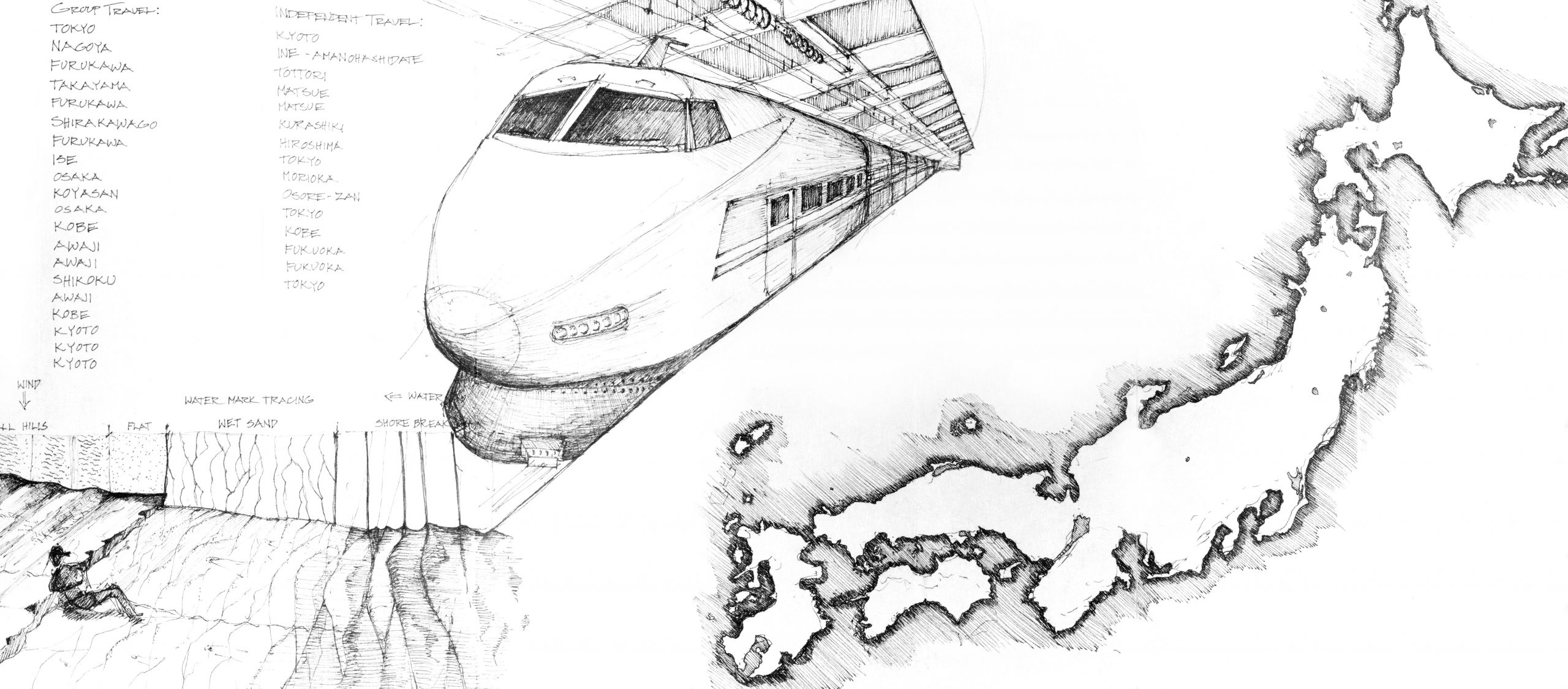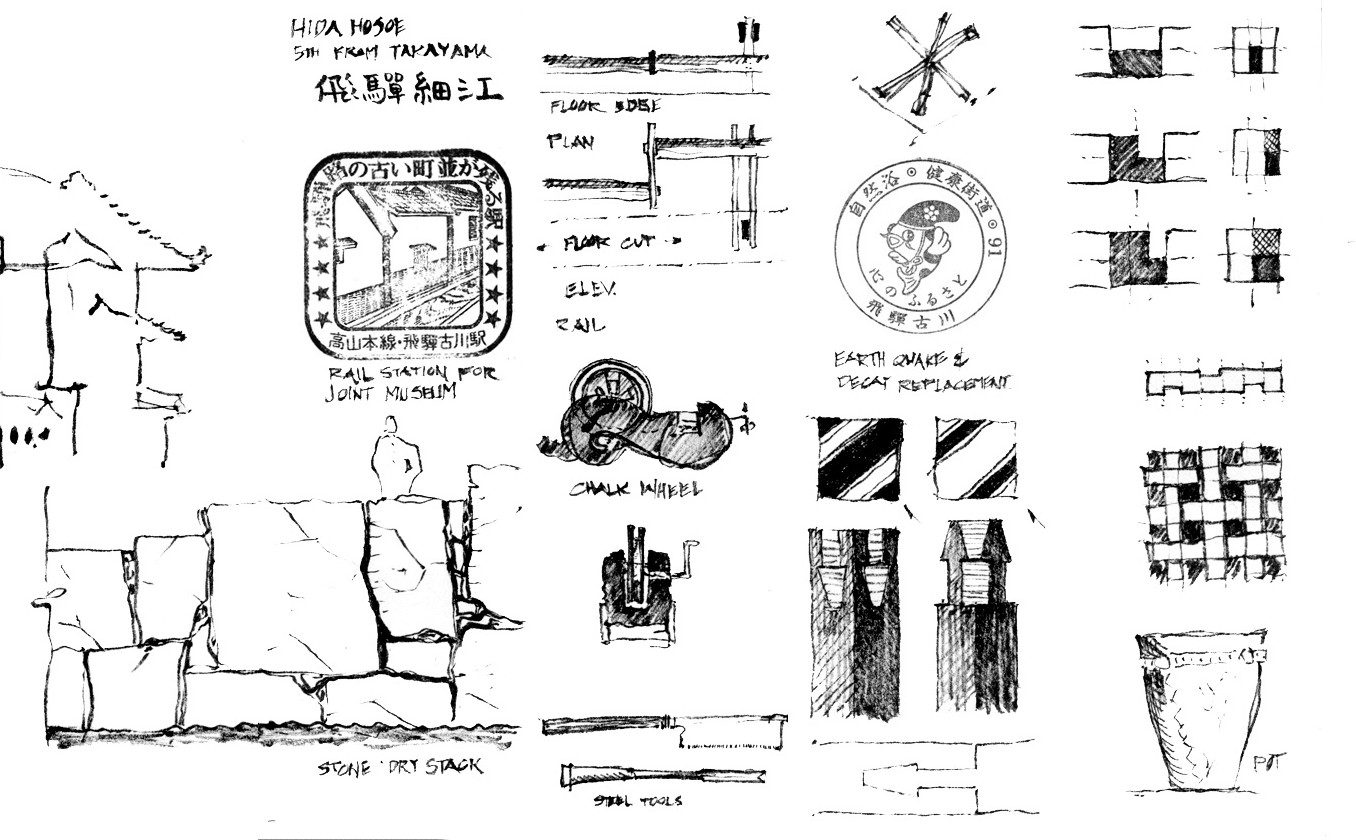5.42-japan-9-detail-d Japanese Experience – Highlights Relevant to Sustainable Design:
This post includes the brief notes on the drawing in additional to the insights on the overall Japanese experience.
Step up and challenge preconceptions.
This railing detail has four circular handholds on each side. The railing design is based on aesthetics and function, with the ergonomics of “pulling” up a stair. Above the stair drawing, an inverted pyramid building sits comfortably in shadow. The building gets bigger as it goes up.
The Japanese Experience:
Japanese Experience: Bonus Insights—The Teahouse and General Observations
We have a lot to learn from each other in the global economy.
The Japanese teahouse is a place where the Skia style is often the most understandable. When we were building a teahouse with Kinya, I remember him asking me, “Charlie, why do you make the column so straight?” Followed by, “Perhaps you make it a little curved!” The teahouse is also a place to understand the quality of Japanese community. A low door always greets visitors. (See the drawing in Japan 4: Detail (d).) Regardless of social status or wealth, all people as they enter must bow to humble themselves in respect for the tea ceremony. The door is not only low but also narrow. Even the mighty shogun must remove their swords and leave them outside. The result is that the teahouse is a special place for people to come together on equal ground.
The hearth is another example of Japanese community. Rather than a fireplace, traditional houses have a fire pit in the middle of the house as a place to gather and share tea. For meals, food is often brought in boxes and bowls that are shared rather than plates and courses for the individual. As well, an empty glass is never filled by the person who is thirsty for more. An observant and sympathetic tablemate takes the bottle or pitcher to fill their friend’s glass. The tradition of sharing beverages is still alive even among the teenage community. Community bicycles were an eye-opener for me in Japan. The idea was pretty simple. If you needed to get from a train station to a restaurant across town, then you would just take one of the bikes that was left unlocked near the station. At the restaurant, someone else might need a bike to get somewhere else, so they would take it. The bikes would literally make their way around the smaller towns, and this spirit of sharing unlocked bikes was initially foreign to me. I quickly embraced it and rode a lot of different bikes! Thirty years later, I saw the Citi Bike “rental share” program in New York City, and I could not help but smile.
Negative observations from my early 1990s experience in Japan came hand in hand with the positive. I saw a selfish culture that has done nothing short of fished almost every giant tuna from the Sea of Japan. I remember going to the fish markets at five in the morning to watch the seafood come in for sushi merchants and restaurateurs. Some of the boats would come from as far as Madagascar laden with their prized catch on dry ice. Imagine fish so big that circular saws had to cut through them and fish so precious that dockside auctions looked like the floor of the Chicago commodities exchange. Natural resources on and around an island with a population the size of Japan inevitably dwindle, but the Japanese have a pension for the best and the most exotic.
I worked on the construction of a house for a member of the feared Yakuza, the Japanese mob. This man had so many big-game hunting trophies from around the world that he wanted to build a house for display alone. Since the largest and the best wood is now gone from the island like the giant tuna, he had shipped from Oregon beams that were a foot and a half wide, three feet tall, and over twenty feet long. A culture that wants the best often also wants the best companies from other countries. The Japanese had started ramping up their interest in buying American assets like the Beverly Hills Palm, Rockefeller Center, and a few film studios.
Children have a far different life in Japan than in America. At an early age, they wear matching hats and backpacks and march off to school in a straight line. The very root of American creativity comes from our individualism, which is such an awesome resource. Foreign buyers of American companies and film studios quickly learn that they must not only buy the hardware but also retain the people to brew up the ideas. In Tokyo, the Americans like me working in the community were primarily involved in creative work: architecture, fashion, and automotive design along with advertising and marketing. We are very good at inventing things and selling. The Japanese are very good at manufacturing. They are smart enough to buy our talent, knowing that their culture has more difficulty cultivating original ideas from their young people than the disciple of executing on the ideas. See the appendix for more on young professionals in Tokyo.
Closing Perspective on the Japanese Experience
Embrace the old and the new. As the Japanese are increasingly using digital technology such as smartphones, they may also increasingly learn that money cannot buy creativity. Ironically they cannot buy the very best asset that we cultivate in America—invention and the spirit of the new. They have much to learn from us, but there is room for us to learn about restraint and discipline from their ancient culture as we charge into the twenty-first century.
Author and illustrator: Charlie Szoradi is an architect, inventor, and the CEO of Independence LED Lighting. He writes about many other topics related to his Japanese experience traveling though the country and working in Tokyo. The drawings and observational notes that started with the Japanese experience set the stage for travel in many more countries over the subsequent decades.
If you have found this posting online, it is an excerpt from Mr. Szoradi’s book Learn from Looking that served as the inspiring seed content for this drawing share resource. For additional drawings and insights on the Japanese experience, we hope that you enjoy exploring LearnfromLooking.com. You can search via general terms such as sustainability as well as narrower terms such as Japanese experience, USA experience, Hungary experience, etc.
If you have any opportunity to travel to Asia, you will most likely see that the Japanese experience is an eye opener at many levels. One key insight into maximizing the Japanese experience is to embed with locals if possible. A local Japanese experience is also enhanced by using the transportation from the bullet trains and local rail to bicycles. From villages to big cities, the Japanese experience covers such a broad range of socio-economic levels that you may only have time to absorb a sub-set of the culture. I look forward to going back to learn more!



